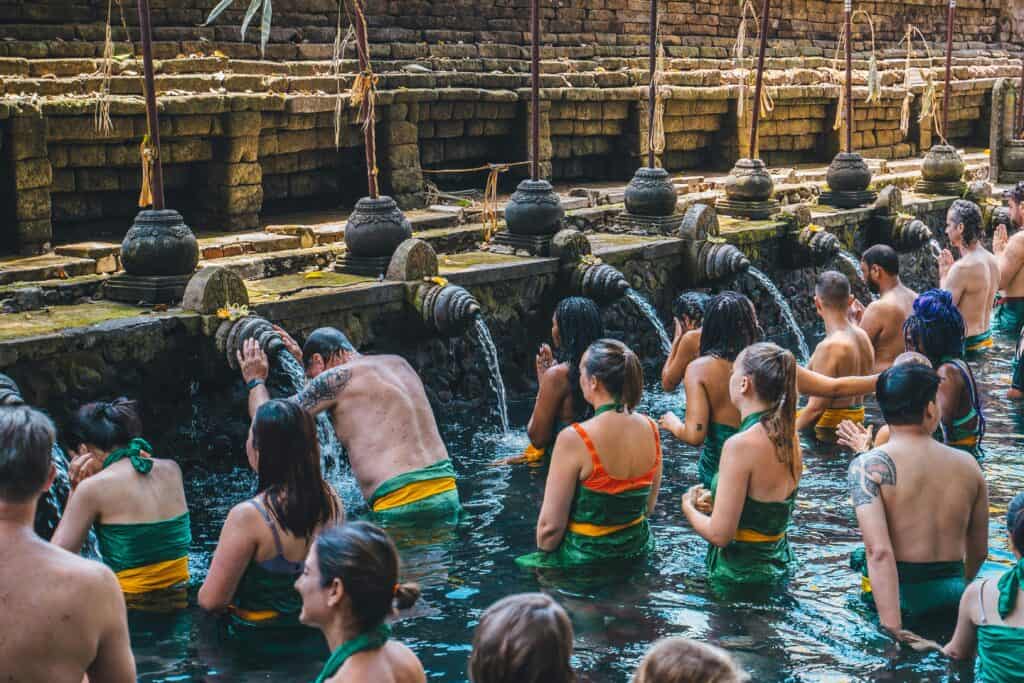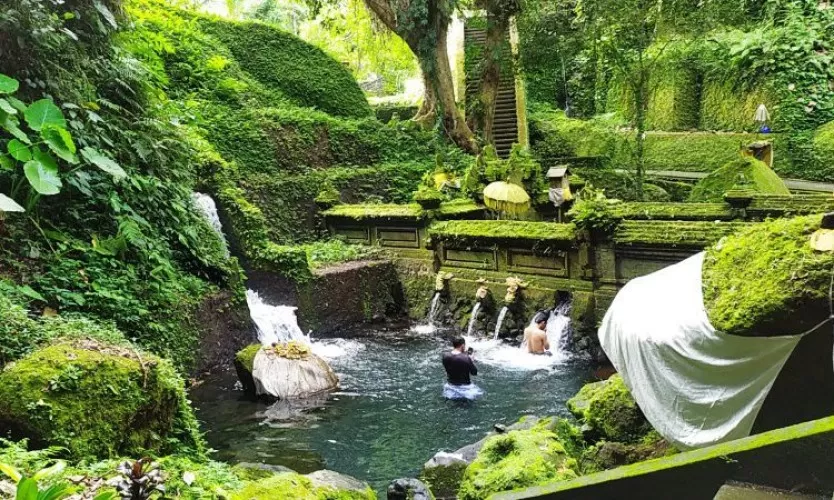Have you noticed the surge of social media posts featuring Melukat ceremonies in Bali? This traditional Balinese ritual has become a hot topic, aligning perfectly with the growing trend of “self-healing tourism” – a much-needed escape after the challenges of recent times. Let’s delve deeper into the Melukat experience and discover its significance.
What is Melukat?
Melukat is a traditional Balinese Hindu ritual that aims to cleanse the soul of negative energy and karma. It is typically performed on auspicious days and at specific locations, such as temples, bathing pools, the ocean, or historical sites.
The ritual involves offerings, prayers, and blessings by a priest, often followed by being sprinkled or immersed in holy water. The water used for melukat can come from various sources, including springs, the ocean, rivers, fountains, or even the home of a Hindu priest.
Melukat is not just a trendy practice; it has been passed down through generations of Balinese Hindus as a way to purify the soul and achieve spiritual renewal.

Lessons Imparted by the Melukat Tradition
As the Melukat tradition gained popularity worldwide, it has attracted the attention of researchers. One such researcher is Desak Seniwati, whose journal titled “Melukat Tradition in the Psychospiritual Life of Balinese Society” delves into the profound insights embedded within this ritual.
- Connecting Generations: Melukat serves as a bridge between past, present, and future generations, preserving ancestral wisdom and strengthening familial bonds.
- Spiritual Connection: The ritual fosters a deeper connection between individuals and the divine, providing solace, inner peace, and a sense of spiritual fulfillment.
- Spiritual Therapy: Melukat has evolved into a form of “spiritual therapy,” offering a holistic approach to well-being by addressing both the mind and spirit.
- Divine Connection and Healing: The tradition recognizes the interconnectedness of physical and spiritual health, emphasizing the role of divine intervention in healing processes.
In essence, Melukat transcends the boundaries of a mere ritual; it serves as a profound guide for personal growth, spiritual enlightenment, and harmonious coexistence with nature and community. By embracing the lessons embedded within Melukat, we can cultivate a more meaningful and fulfilling existence.
Things to Know Before Melukat
As the Melukat tradition gains popularity, it’s crucial to be mindful of the cultural and spiritual significance of the ritual. Here are some essential guidelines to ensure a respectful and enriching experience:
- Menstrual Restrictions: Women who are menstruating are prohibited from participating in Melukat to maintain the sanctity of the ceremony.
- Respectful Language: Maintain respectful language throughout the Melukat process. Avoid using profanity or harsh words.
- Adhere to Local Rules: Each Melukat site may have specific rules and regulations. Familiarize yourself with these guidelines before participating.
- Cultural Sensitivity: Show respect for local customs and traditions. This includes participating in offerings or wearing appropriate attire as instructed.
- Simplicity in Bathing: During Melukat, refrain from using toiletries like soap, shampoo, or toothpaste. Allow the natural cleansing power of the holy water to take effect.
- Appropriate Attire: Dress modestly and respectfully during the Melukat ceremony. Avoid revealing or inappropriate clothing. Opt for traditional Balinese attire if available.
By following these guidelines, you can ensure a harmonious and respectful Melukat experience, honoring the cultural and spiritual essence of this Balinese tradition.
When Did Melukat Gain Widespread Popularity?
As Melukat gains traction worldwide, many wonder when this Balinese spiritual cleansing ritual first captured public attention. While Melukat has long been a sacred practice among Balinese Hindus for spiritual rejuvenation and tranquility, its popularity among non-locals has surged in recent years.
According to Anak Agung Gede Putrawan, the Head of Gianyar’s Tourism Office, Melukat’s exposure to a wider audience can be traced back to the opening of Tirta Empul, a renowned Melukat site, 15 years ago. This coincided with the site’s growing recognition as a spiritual destination.
Data from the Gianyar Tourism Office indicates that since 2019, Tirta Empul has welcomed over 941,781 visitors, either for Melukat or general sightseeing. While the COVID-19 pandemic caused a temporary dip in visitation in 2020 and 2021, tourism has gradually rebounded, with 84,333 visitors returning to Tirta Empul in 2022.
The growing popularity of Melukat can be attributed to several factors:
- Increased awareness of Balinese culture and spirituality: As Bali gains recognition as a spiritual tourism hub, Melukat has become a sought-after experience for those seeking spiritual rejuvenation and cultural immersion.
- Social media exposure: The rise of social media has played a significant role in showcasing Melukat to a global audience, attracting individuals interested in unique and transformative experiences.
- Self-healing and wellness trends: The growing emphasis on self-care and holistic wellness has aligned with the perceived benefits of Melukat, such as stress reduction, emotional cleansing, and spiritual renewal.
As Melukat continues to gain popularity, it’s crucial to approach the ritual with respect and understanding, adhering to local customs and traditions to preserve its cultural and spiritual significance.
Where to do Melukat?
We’ve made a separate article regarding this, you can read more on a full list of temples in Bali where you can do Melukat ceremony.


